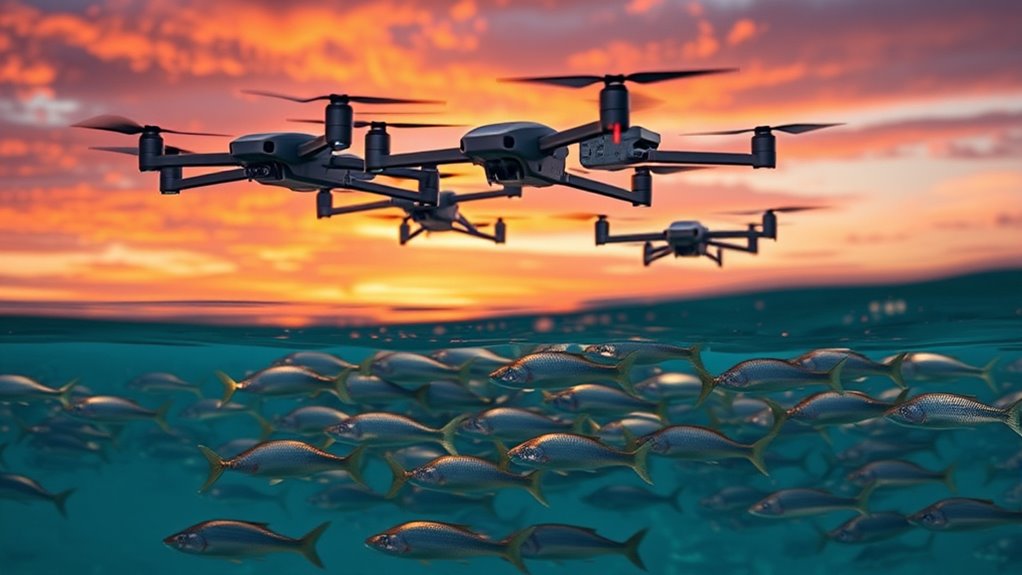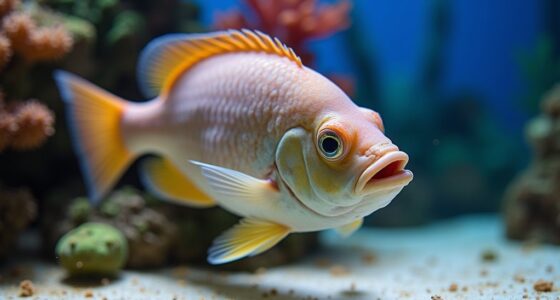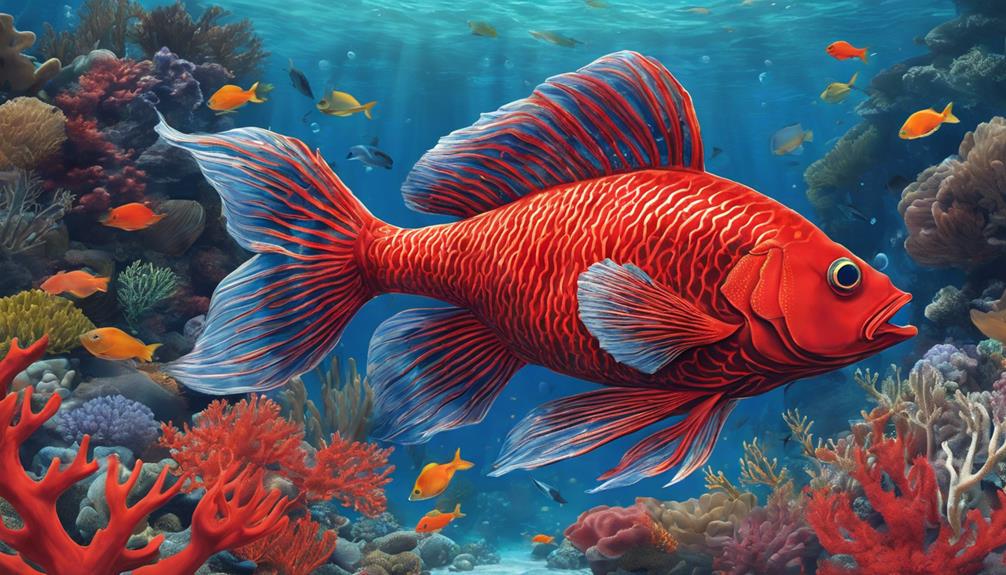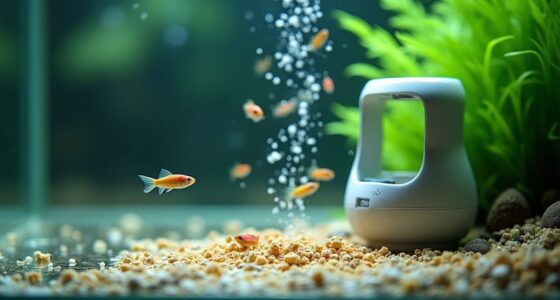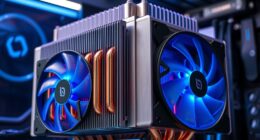Using a fish schooling algorithm helps your swarm drones coordinate naturally by mimicking how fish swim together. It relies on simple rules like alignment, separation, and cohesion to promote cooperation, adaptability, and resilience. This biologically inspired approach enables your drones to avoid obstacles, optimize paths, and respond quickly to changes in the environment. If you keep exploring, you’ll discover how these behaviors can markedly boost your swarm’s efficiency and flexibility in diverse tasks.
Key Takeaways
- The Fish Schooling Algorithm models natural fish behaviors to enhance coordination and flexibility in drone swarms.
- It improves obstacle avoidance and path planning by mimicking collective fish movement strategies.
- The algorithm promotes scalable, cooperative control, enabling large drone groups to operate seamlessly.
- It balances exploration and exploitation, optimizing task coverage and environmental responsiveness.
- Implementing fish-inspired behaviors increases resilience and adaptability of drone swarms in dynamic environments.
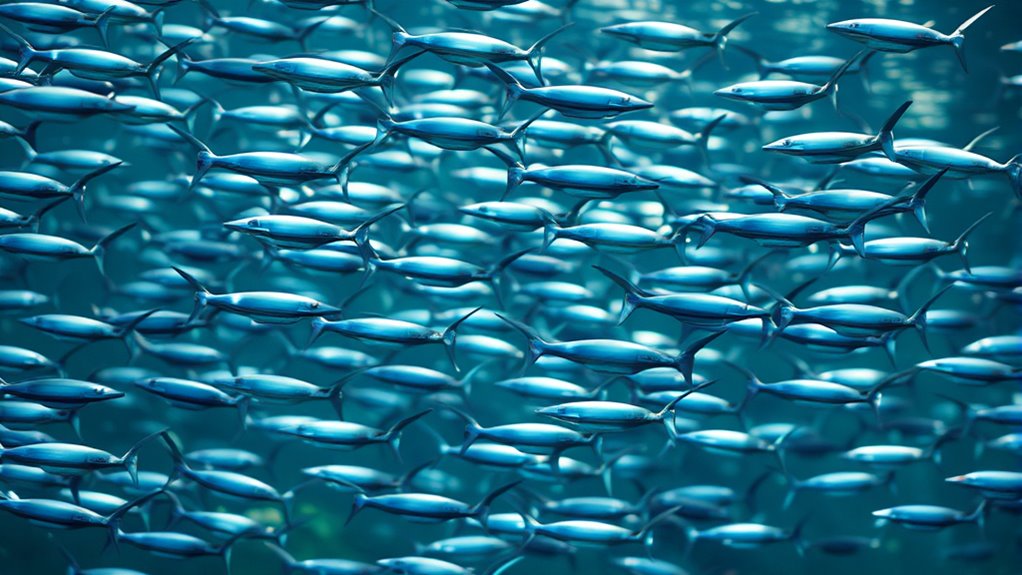
The Fish Schooling Algorithm is a nature-inspired optimization technique that mimics the collective behavior of fish swimming together. It models how fish coordinate their movements within a school, which can be remarkably efficient in exploring and exploiting their environment. When applied to swarm drones, this algorithm enhances swarm coordination, allowing multiple drones to work seamlessly as a cohesive unit. The biological modeling behind fish schooling provides a framework for developing algorithms that promote cooperation, adaptability, and robustness in drone swarms. By understanding how fish adjust their positions based on neighbors’ movements, you can implement strategies that help drones avoid obstacles, optimize paths, and perform complex tasks more effectively. Additionally, the algorithm benefits from the dynamic adaptation capabilities observed in natural fish schools, enabling drones to respond quickly to environmental changes.
This algorithm leverages biological modeling to simulate behaviors like alignment, separation, and cohesion among the drones. Similar to fish in a school, drones adjust their trajectories based on the positions and velocities of their neighbors, ensuring they move collectively without collisions or disarray. This adaptive behavior results in a swarm that can dynamically respond to environmental changes, making it ideal for applications such as search and rescue, environmental monitoring, or military reconnaissance. The biological inspiration provides a natural, flexible approach to control, which often outperforms traditional centralized methods that can be rigid and prone to failures if one unit malfunctions.
Incorporating the Fish Schooling Algorithm into drone systems means you can improve how your swarm manages tasks that require coordination over large areas or complex terrains. The algorithm’s strength lies in its ability to balance exploration and exploitation—drones can cover new ground while still honing in on specific targets or areas of interest. Because it’s rooted in biological modeling, the algorithm naturally accounts for uncertainties and variations in the environment, making your drone swarm more resilient and adaptable. It also simplifies the process of scaling up the number of drones, as the rules governing their interactions remain consistent regardless of swarm size.
Frequently Asked Questions
How Does the Algorithm Perform in Complex, Real-World Environments?
You might wonder how well this algorithm handles complex, real-world environments. It excels in environmental robustness, adapting swiftly to unpredictable changes and obstacles. Its adaptive coordination allows your swarm drones to communicate and respond dynamically, maintaining efficiency even in challenging scenarios. This continuous adaptability guarantees your drones operate seamlessly, making the algorithm highly effective outside controlled settings, and supporting diverse applications where resilience and flexible cooperation are essential.
What Are the Energy Consumption Implications for Swarm Drones?
You’ll find that energy efficiency and power management are vital for swarm drones, especially in extended operations. The algorithm helps optimize their movements, reducing unnecessary energy use and conserving battery life. By improving coordination, it minimizes power drain during communication and maneuvering. This means your drones can operate longer, perform complex tasks more effectively, and avoid frequent recharging, ultimately enhancing overall mission success while maintaining sustainable energy consumption.
Can the Algorithm Adapt to Unpredictable Changes in the Environment?
Imagine a school of fish darting through turbulent waters, adjusting instantly to swirling currents and sudden predators. You see how this reflects environmental adaptability in swarm drones. The algorithm’s design enables your drones to handle unpredictability by mimicking this behavior, allowing quick responses to changing conditions. With such unpredictability handling, your swarm remains resilient, adapting seamlessly to unforeseen challenges—just like a school of fish steering through unpredictable ocean currents.
How Scalable Is the Fish Schooling Algorithm for Larger Drone Swarms?
When considering scalability, you’ll find that larger drone swarms face significant challenges in maintaining effective swarm coordination. Scalability challenges arise as the number of units increases, making it harder to manage communication and coordination efficiently. The fish schooling algorithm can handle moderate growth well, but as the swarm expands, you’ll need to refine the algorithm to ensure it remains effective and responsive without overwhelming the system.
Are There Any Limitations or Challenges in Implementing This Algorithm?
Did you know that many algorithms face over 50% slowdown with larger datasets? When implementing this algorithm, you might encounter computational complexity that hampers real-time performance. Implementation challenges include ensuring reliable communication among drones and managing energy use efficiently. These issues can limit scalability and effectiveness, making it essential to optimize both hardware and software to overcome limitations and fully leverage the algorithm’s potential in real-world swarm applications.
Conclusion
So, congratulations! Thanks to the Fish Schooling Algorithm, your swarm drones now mimic fish rather than, say, responsible robots. Who knew that swimming in circles could lead to smarter, more efficient drones? Just imagine the future—drones schooling like fish, probably arguing about who’s the best swimmer while ignoring your commands. But hey, at least they look cute doing it. Maybe next, they’ll learn to avoid actual fish. Now, that’s progress!
